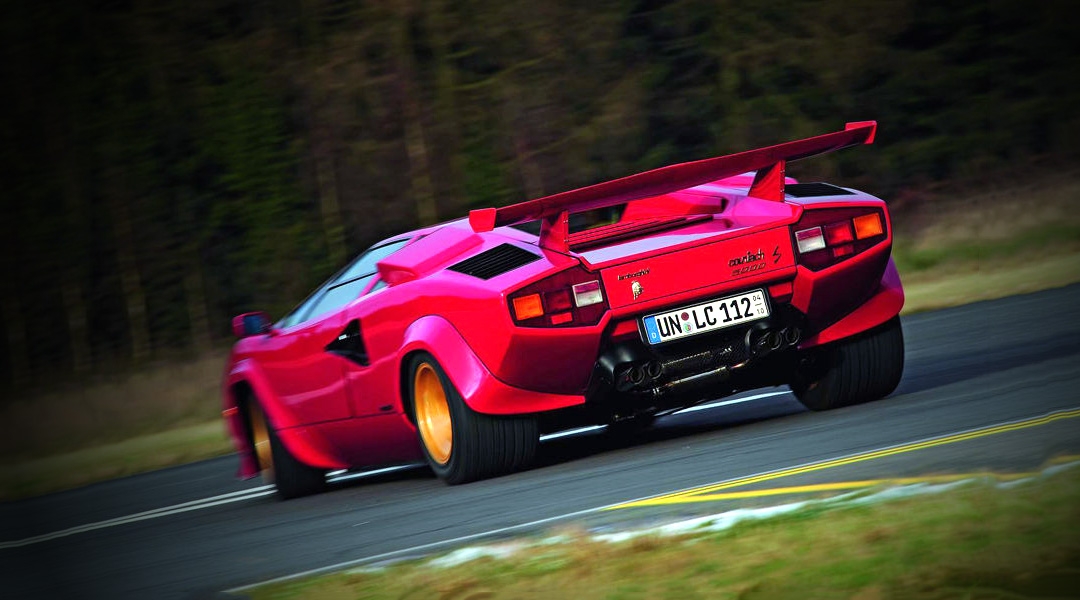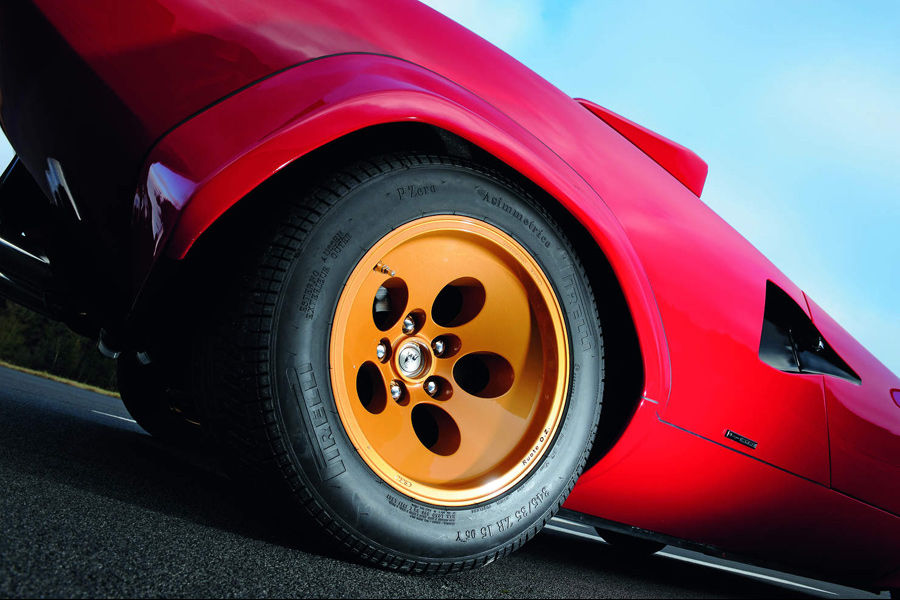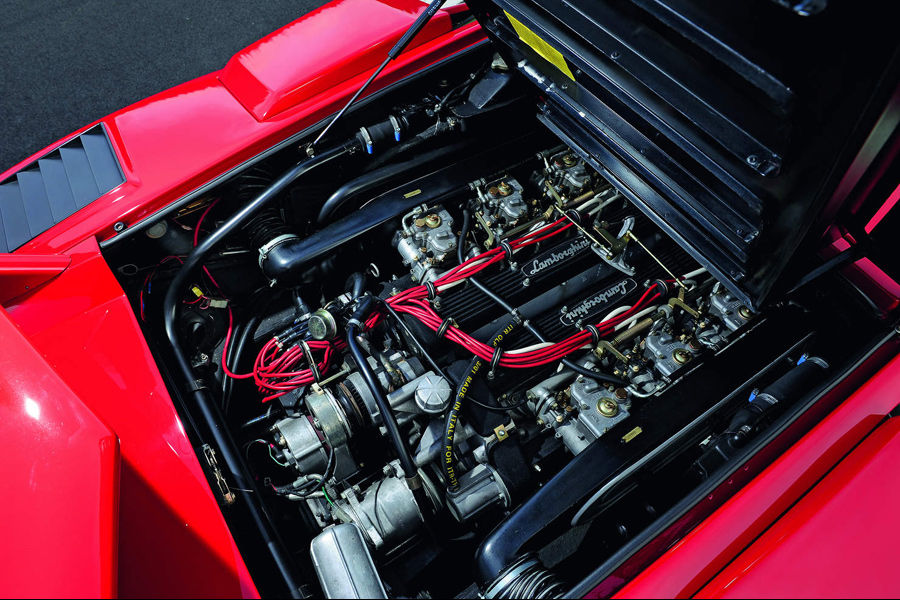
The ultimate sensation – Lamborghini Countach LP500S 1984 road test. It’s the most outrageous looking car on four wheels, but has it got the substance to go with the image? We’ve got the shattering figures that tell all…
Half the charisma of the Countach is what happens at journey’s end. To arrive anywhere in it is to take a shortcut to celebrity park it, and you create an instant tourist attraction. Some ask if they can sit in the driver’s seat for a few moments. Others merely want to look at the engine. The witty ones ask you what it’s like to fly. Passing motorists don’t just stop and park to get a closer look: they take photographs of it. If nothing else, the Lamborghini Countach is the ultimate visual statement on four wheels.

The product of a wealthy industrialist’s dream to create the supreme no-compromise performance car, the Countach has become everyman’s dream car. Since its stunning Bertone shape was first seen as little more than a styling exercise at the 1971 Geneva Show, the Countach has become the stuff of fantasy and legend a distant object of desire as elusive as the wind. Through ten years of fragmented production, white the factory stumbled from one financial or labour crisis to the next – its ownership changing hands almost as frequently as the Italian Government — barely 500 Countaches have left the S. Agata production lines. Of those, perhaps only 50 still prowl British roads.
| MAXIMUM SPEEDS AT TEST | |||
| Gear | mph | kph | rpm |
| Top (mean) | 155 | 249 | 5600 |
| (best) | 157 | 253 | 5800 |
| 4th | 151 | 243 | 7000 |
| 3rd | 119 | 192 | 7000 |
| 2nd | 80 | 128 | 7000 |
| 1st | 58 | 93 | 7000 |
Mirroring the traumas at home base, the marque’s presence in Britain has been intermittent, its relationship with Motor at times tempestuous. In the early ‘Sevenths, under a previous importer, the cars often proved fragile, reluctant to match the performance claims made for them Only once before, in 1975, has Motor put a watch to a Countach, and that was an early 4-litre example with a still tight, low-mileage engine. It was a fast car 0-60 mph in 5.6 seconds: but it wasn’t as quick as its makers claimed, and its engine was hopelessly intractable We had no opportunity to prove it, but we judged its claimed 190 mph maximum speed to be pie in the sky.
| Standing 1/4-mile: 13.2 sec, 69 mph | ||||||
| Standing km: 24.0 sec, 119 mph |
For a few years, after the factory went into receivership in the late Seventies. Lamborghini faded from the UK scene altogether, not to re-appear until the back end of 1981. By then, the purity of the original LP400 Countach shape had given way (in 1978) to the macho S. with as optional rear wing and flared wheel arches to accornmo date Pirelli’s massively wide P7 tyres. Other alterations introduced at the same time included larger-diameter ventilated discs front and rear, a new steering rack, radically revised geometry for the double wishbone front suspension, and a complete redesign for the rear.
In 1982, the Countach became the LP500S, when increased bore and stroke for its lengthwise quad cam V12 pushed the capacity out from 3.929 to 4.754cc. Still breathing through six fat twin-choke Webers, its claimed maximum power remained at 375 bhp but was produced at 7000 instead of 8000 rpm. with correspondingly improved torque characteristics, from 268 lb ft at 5000 rpm to 302 lb ft peaking 500 rpm lower in the rev range Ratios apart, the unusual transmission remained as before, with the gearbox up front beneath the driver’s elbow, and the drive passed back to the differential at the rear by a shaft beneath the engine.

Still, though, a definitive road test remained tantalisingly elusive. When a rival magazine tested the LP500S in Italy, they too, had to make allowances for a barely run in, low-mileage engine. The suspicion began to take hold that the Countach was destined always to remain the subject of rumour and fantasy: at best, a barely usable road-racer; at worst, a £55.000 sham, all show and no go.
The first inkling that perhaps there was some substance behind the image came when we drove an elderly privately owned example at Donington. Its brakes were shot and its gearchange was obstructive. but it rode well on the road to the circuit and handled like a dream through the track’s fast sweepers Then last year, at the Isle of Wight, we drove another Countach to victory against five other supercar candidates for the title of Fastest Production Car in the World. A few months later, in appalling weather. Barry Robinson and Alex Postan drove Barry’s Countach round Millbrook for several hours to set 12 new UK outright land speed records ranging from 154 78 mph over 5 km to 131.87 mph over 500 km.
It is the same car that we test here, so this time we know the car is a good un. The engine, say the importers Portman Garages, is standard apart from a factory option exhaust system — but it’s a selected unit that varies on the high side of the factory’s ±25 bhp production tolerance, which means closer to 400 bhp than the nominal 375 bhp quoted in the brochures Would it really do “over 180 mph” and outspnnt an Aston Martin Vantage? This time there could be no excuses.
Getting the acceleration times was the easy part — almost unbelievably so. As supercars go, the Countach is a dream to squirt: its meaty metal-gated gearchange is no flick switch, but it’s supremely positive and takes snatched shifts m its stride. Drop the clutch at 4500 rpm floor the loud-pedal. and perfectly controlled wheelspin keeps the revs hovering around 7000 rpm until road speed catches up with engine speed at around 50 mph. Then slam it through the dogleg into second, and almost as soon as the clutch bites we’re catapulting past 60 mph. On our first run, upwind, we clock a 4.9 to 60 and low elevens to the ton. Coming back downwind, it’s the same again. Our third run past 60 stops the watch at 4.8 seconds, and by the fifth run we’ve got a 4.8 each way. No change to the 0-100 mph times which average out at 11.3 seconds; 120 mph comes up in 17.4 seconds, 140 mph in well under 30 seconds still with ample broking room within MIRA’s mile-long straights. Were happy to call it a day (the car is privately owned, after all). After a three year reign the Vantage has been vanquished, and not by just a tenth here or there. The table tells it all.
But for all our efforts, the ultimate potential of a flat-out Countach must remain a matter for conjecture. We tried, but m the end it I proved logistically impossible to take the car to Germany and we had to settle for the banked track at Millbrook, where we knew that cornering forces would wipe some five mph off its maximum speed. As it turned out, though, even that proved less of an inhibition than the car’s own built-in air-brake, its rear wing. Strictly speaking an extra-cost, aftermarket option, the wing does wonders for high speed stability and even more for its crowd-pulling looks, but aerodynamically it’s a drag: according to the factory, about 10 mph worth. So in the end, with the wing, and on a damp track but m otherwise friendly testing weather, our Countach was all out at 155.1 mph, with nothing more to come. That’s the fastest we’ve yet lapped round Millbrook and probably worth 160 plus on the flat, but it’s a far cry from more than 180. Then again, without the wing you’re looking at a believable 170 mph, may be even 175 on a good day Perhaps some other time…

Credentials proven as a test-track sprinter, the Countach also served time with us as a road car. The neighbours are still talking about it. To start it from cold, you half turn the key and then allow a few seconds for the fuel pumps — noisier than most cars’ engines — to prime the carbs. Then pump the throttle, which is heavier than some cars’ clutches, and turn the key. It fires instantly, like a small explosion, making nearby householders fear for their foundations. Sometimes the engine dies again just as suddenly. It invariably keeps running after the second attempt, but you’ve got to coax it along till it’s properly warm.
Even then, it demands a delicate right foot at low speeds. If you floor the throttle fully at less than 1800 rpm, the wick goes out completely — and re-lights as soon as you back off again. Between 1800 and 2000 rpm it remains patchy: too much throttle, or too sudden, and there’s an embarrassing gobble-gobble-burp before the engine picks up cleanly. So, easy on the throttle at traffic trickling speeds, nurse it through the ragged patches: the real shove starts at 2000. From then on, the power is there all the way, at any speed, in any gear, part-throttle or full. Stagger your passenger with a demonstration of time-warp thrust m second gear — and then, as the engine comes fully on cam at 4500 rpm, floor the pedal the rest of the way. The power doesn’t start to fade until the tachometer is reading 7500 rpm, still 500 short of the red line, and already you’re laying your licence on the line. Change up into third and despite an oddly wide gap in the ratios the charge resumes with virtually undiminished acceleration to within a whisker of 120 mph.
Fourth is tall enough to take you to 150 mph; yet, once you’re over the low-speed stumbles, it’s a gear for relentless acceleration that still the mighty Vantage cannot better. Only in top, a rangy 24.4 mph per 1.000 rpm in the Countach, can the Aston and (in the middle speed ranges) the Porsche Turbo (911 Turbo 930) turn the tables.
Overlaying it all there’s the howl of the engine; a raw. savage sound — mainly induction and exhaust, and thus very much throttle-dependent — that’s strangely at odds with the mechanical smoothness of the engine itself. A difference between what you feel and what you hear. In the Countach it’s all the sound of power, except whore a decline lets you ease off the throttle enough to uncover the rumble of the tyres or the high-pitched whine of the gears, like the sound of a taxiing jetliner. If there is any wind noise, you’ll never hear it. You won’t hear much of the radio, either, even at 70 mph, let alone at autobahn velocities. The gearing is tall enough to make three digit cruising speeds an easy canter for the car, but the occupants need ear-plugs.
Yet it’s high speeds that reveal the handling at its best. Stability in a straight line is impeccable, body lean through corners virtually non-existent. The Countach soars through long fast sweepers with precision and poise that will outlast the courage of all but the most heroic driver.
Lower down the speed range, as the curves get tighter, the sheer tyre trip remains but the chassis balance deserts it. Barry agrees that this car understeers more than his last Countach (the one we drove at Donington). That car was marvellously balanced, understeering mildly under power unless you wilfully nudged the tail out with the throttle, gently tightening its line if you backed off. But this car understeers determinedly at the limit, even through low-gear bends, with the steering — beautifully weighted, precise and communicative at modest cornering forces — heaving-up dramatically in proportion. It takes dire provocation to unstick the tail in the dry. And even in the wet the Countach remains astonishingly forgiving and sure-footed, whether thrashing along a country backroad or cruising at 130 mph on an autobahn. Like the Donington car, this one is vice less on lift-off. The brakes mirror the chassis. The solid pedal feels somewhat dead and wooden in gentle stops when the discs are cold, but they warm to their task magnificently when what you need is a hard stop from 140 mph-plus. At MIRA, we appreciated that.
The solid metal suspension joints don’t do much for the low speed ride. With no rubber insulation to take the sharp edge off read imperfections, the suspension is harsh and busy-sounding around town, though never seriously uncomfortable. Comfort improves in direct proportion with road speed, fine on a motorway and superbly controlled over undulations.
So much for the dynamics. The Countach as a driving machine doesn’t provide any soft options, but where it matters, it delivers. In terms of habitability and practicalities, there’s no shortage of predicable flaws, yet it’s better than you’d expect.
Getting the door key into the downward-facing lock-button is fiddly, but the vertical-opening doors make a lot of sense in tight spaces. There’s no elegant way of getting in, the best bet being to go in backwards, siding your posterior across the vast expanse of leather-trimmed sill until you reach the seat, and then pulling your legs in after you. The fixed-backrest seat promotes a curved-spine posture so there’s no lumbar support to speak of, and the rocking adjustment action means that an upright backrest can only be achieved at the expense of thigh support, or vice versa. With experimentation, though, you can find a pretty fair compromise — unless you’re much over 6 ft in which case you’re likely to run out of headroom. Although sited high on the massive central divide the gearstick is in easy reach, and with a good range of telescopic adjustment you can achieve a nicely judged reach to the chunky-rimmed wheel. The pedal layout, however, needs pretty good articulation of your knees and ankles Your throttle foot is forced well over to the left by the hugely intrusive wheel arch, yet you’ve got to crank your knee over to the right to clear the wheel. Heel-and-toe gearchanges are virtually impossible, and there’s only enough space for smallish shoes on the left footrest. Yet for all that the Countach isn’t particularly uncomfortable on a long run. The switchgear is straight forward and easily learned, and the instrumentation — by mildly reflective, individually-glassed round dials — is comprehensive, though the mph; kph markings on the 200 mph speedo are a cluttered mess and at least two of the five ancillary dials (oil and water temperature, oil pressure, fuel level and battery volts) are obscured from most drivers’ view by the wheel rim.
Predictably, seeing out poses its share of problems. Over-the-shoulder vision is effectively non-existent, and half the field of view through the interior rear-view mirror is obscured by the rear wing. At night, the lights of cars behind re fleet distractingly off the inner faces of the rear buttresses You realty need those twin electrically adjustable door mirrors. The view forward is OK (though you can’t see any of the car forward of the base of the screen) and powerful quadruple headlamps are matched by the massive single screen wiper which, incredibly, continued to clear the screen effectively even at maximum speed.
Confusingly marked controls, and demister vents which can only be opened or closed by hand — a long stretch from the driver’s seat — don’t bode well for the efficacy of the heating system. In practice, misting up was never a problem and the heater is adequately effective, if slow and unprogressively in its response to adjustment. With a window aperture which at its maximum measures barely two inches deep, air conditioning is a very necessary standard fitment for hot weather, but the best thing is that it’s completely separate from the heater system which means that a warm toes/cool nose cliché is easy to obtain. For an Italian exotic, that’s a rare virtue indeed.
While its under-the-skin finish might not bear too close an inspection. visible build good, with well formed and tidy-fitting panels.
Did someone ask about fuel consumption? For the record, we got 11.1 mpg. Does it matter? We’re not talking about just A to B transport here. In fact, the Countach is a more road-usable proposition than our early scepticism had prepared us for, but even so most owners can afford a Mercedes as well for daily use. The Countach isn’t Porsche-practical.
Yet don’t dismiss it as just a plaything for rich posers. Perhaps some people who buy them are just that, but others are serous drivers.
When he’s not operating a demolition business. Barry Robinson is a weekend racer of real talent, and he’s on his second Countach. Beyond the charisma and beneath the dream-car shape, there’s a car of real substance and ability which, by our figures, is the ultimate production car. AII you want to, and if you can afford it, buy a Countach as a car to be seen in; but if you’ve got the driving skill and the automotive appreciation, but it for what it is.





